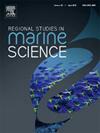Long-term increasing water quality trends in Hakodate Bay, Hokkaido, driven by meteorological factors
IF 2.1
4区 环境科学与生态学
Q3 ECOLOGY
引用次数: 0
Abstract
Ensuring optimal water quality in Hakodate Bay by curbing eutrophication has been pivotal since Japan's water pollution control law was implemented in 1970. However, recent ecological disturbances, such as Karenia mikimotoi blooms since 2015, have raised water quality concerns. This study employed exploratory data analysis and dynamic factor analysis (DFA) to analyze water quality parameter trends—such as chemical oxygen demand (COD), total nitrogen (TN), total phosphorus (TP)—across seven stations in Hakodate Bay from 1977–2023. Climatic variables, including air temperature, total daily precipitation, wind speed, and solar radiation were used as explanatory variables. Higher COD, TN, TP, and lower salinity were observed inside Hakodate Port waters. High correlations among salinity, COD, TN, and TP at station 3 suggest the influence of river inflow because of its location near the Kunebetsu River. Increasing COD trends were observed in all stations (Mann–Kendall τ = 0.208–0.325, p < 0.001). The DFA model for COD shares a single trend with two explanatory variables: average daily air temperature and wind speed. The model for TP had a common trend with three climate covariates. However, the model only explained < 30 % of the variation in TP. The best DFA model for TN, which included a common trend and two covariates similar with COD explained only < 10 % of the variability in TN. Our findings suggest that climate change may undermine efforts to reduce organic matter pollution in Hakodate Bay, while ruling out meteorological factors as the primary drivers of nutrient dynamics.
求助全文
约1分钟内获得全文
求助全文
来源期刊

Regional Studies in Marine Science
Agricultural and Biological Sciences-Ecology, Evolution, Behavior and Systematics
CiteScore
3.90
自引率
4.80%
发文量
336
审稿时长
69 days
期刊介绍:
REGIONAL STUDIES IN MARINE SCIENCE will publish scientifically sound papers on regional aspects of maritime and marine resources in estuaries, coastal zones, continental shelf, the seas and oceans.
 求助内容:
求助内容: 应助结果提醒方式:
应助结果提醒方式:


